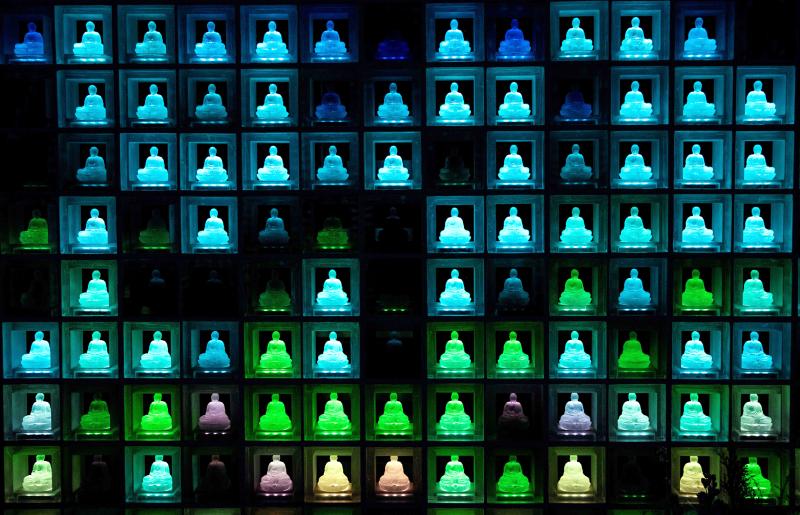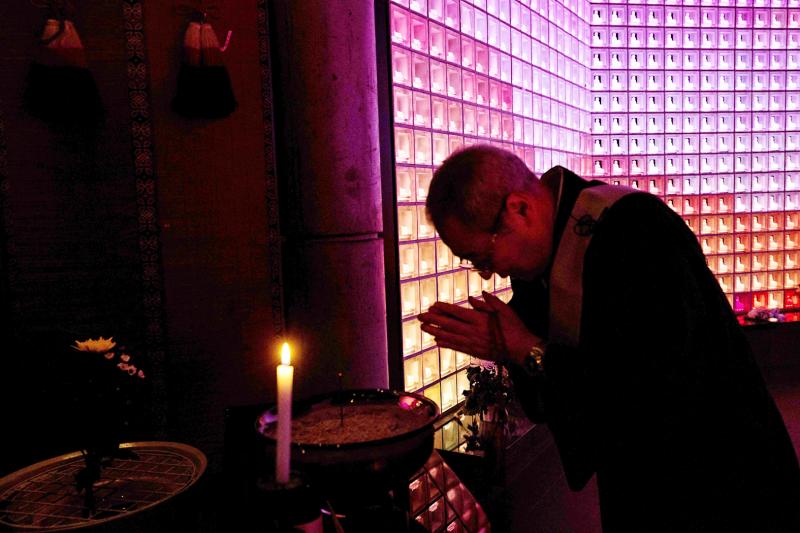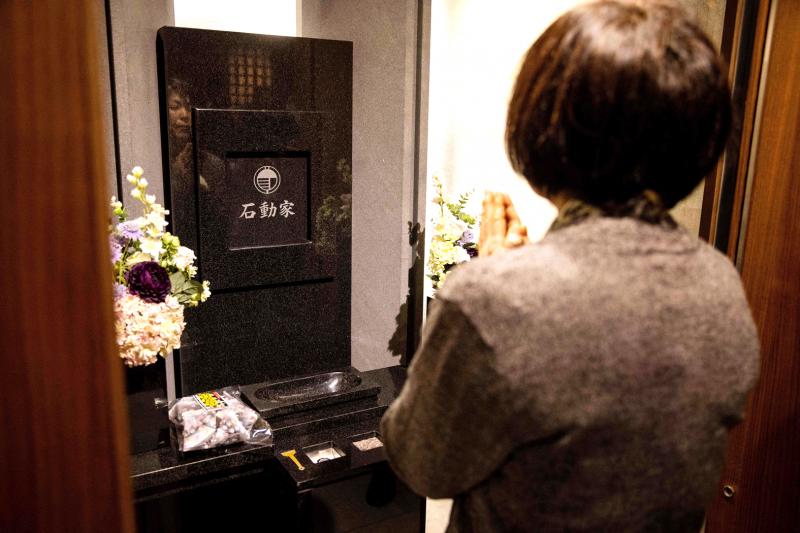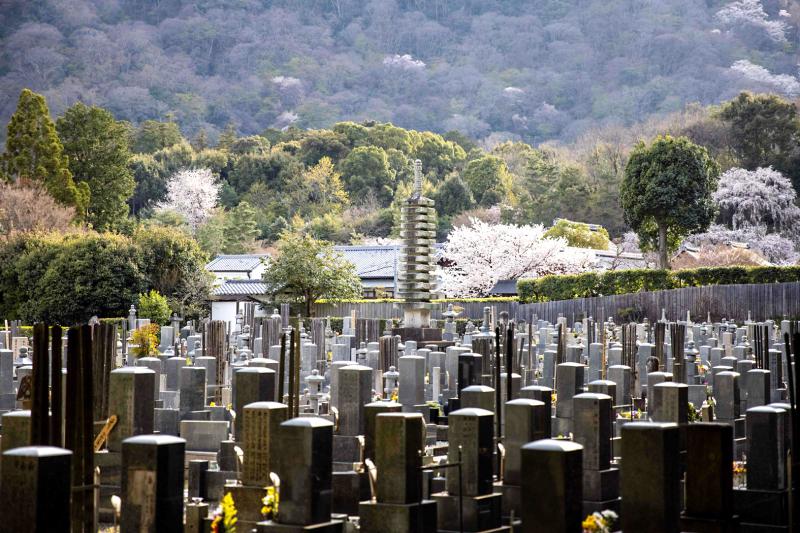Masayo Isurugi settles into a booth on the sixth floor of a sleek Tokyo building, scans an ID card and waits for an automated system to deliver her late husband’s ashes.
More and more people in Japan are breaking with traditions on burial and mourning, swapping hometown graveyards for modern takes on cemeteries.
As the 60-year-old waits in one of 10 mourning booths on the floor, cranes behind the walls move almost silently and retrieve the zushi box with the urn containing her late husband Go’s ashes.

Photo: AFP
Chic wooden doors inside the booth quietly part like an elevator at a luxurious hotel and a gleaming, dark-stone altar emerges with Go’s zushi box as its centerpiece, while a photo of him appears on a monitor.
“Initially, I thought maybe these facilities might feel cold and that I might prefer a traditional grave on soil,” Isurugi said.
“Now I feel it’s better to have a place where I can visit whenever I want and offer prayers, rather than having a family grave that I could rarely visit.”

Photo: AFP
Her family considered a traditional cemetery, but it was a two-hour train ride away. The Kuramae-ryoen facility is only brief bus ride from Isurugi’s house and she can visit after work.
Traditionally in Japan, cremated remains are placed in family tombs used over many generations and tended by the family’s eldest sons.
But Japan’s disproportionately graying population makes for an imbalance between the number of new graves needing tending and the young people willing and able to do it.

Photo: AFP
Families are increasingly moving to urban areas far from ancestral graveyards, and many elderly don’t have sons who can take on the traditional responsibility.
‘A NEW STYLE’
Tomohiro Hirose, resident monk at the temple that supervises the Kuramae-ryoen facility, has a traditional cemetery with some 300 graves.

Photo: AFP
“But about half of the graves no longer have anyone in the family to look after them,” he said.
To address the problem, a crop of modern, indoor cemetery facilities have emerged, offering to store remains for a set period, often up to three decades.
The ashes are eventually transferred to collective memorials, but individual names or QR codes are engraved on plaques to provide some personalization, and monks pledge to continue offering prayers for the souls of the departed.
Facing a busy boulevard in the Japanese capital, Kuramae-ryoen features warehouse-style industrial stacking racks that can store 7,000 zushi boxes, each of which can hold two urns or the bagged ashes of up to eight people.
Hirose decided to build the site after the temple’s old building was badly damaged in the 2011 earthquake. He felt the new building, which includes a temple, his living quarters and the cemetery facility, would revitalize a site that dates back to 1608.
“This offers a new style. Many families find it easy to visit their graves,” Hirose said.
The cemetery uses machinery developed by Daifuku, a firm that produces storage, transport and collection systems for factories and warehouses.
“Our company has built systems for around 60 [cemetery] facilities across the country,” said Hidenobu Shinnaka, a senior official at Daifuku.
The first order came in the 1990s, and more recently there has been interest from other Asian markets too, he said.
‘A WARM-HEARTED MANNER’
Modern cemetery sites are not only often more convenient, but cheaper.
An average spot costs around US$7,100, roughly half a traditional grave site, according to Kamakura Shinsho, a company that helps connect customers with cemeteries.
Other modern cemeteries are not big enough to need machinery, but incorporate other novel features.
Kokokuji temple, founded in Tokyo in 1630, has created a unique octagon-shaped space with walls of floor-to-ceiling displays of individual glass Buddha statuettes.
Each of the statues — over 2,000 in all — symbolizes an individual whose ashes are stored there. When visitors scan an ID or enter a family name, the Buddha assigned to their loved one is illuminated.
The entire display can also be lit, and the system can produce various mosaic patterns with different statues illuminated in a variety of colors to produce a calming ambiance in the dim sanctuary.
The display is meant to show that each of us is surrounded by many more, and all will join Buddha in the after-life, said resident monk Taijun Yajima, who built the Ruriden facility with artists and engineers.
He says mourning remains the same even in modern cemeteries.
“Children should look after the graves and the souls of parents... But in some people’s reality, it is simply not possible,” he said.
“I thought about how those people can be laid to rest in a warm-hearted manner, and this is the answer.”

This year will go down in the history books. Taiwan faces enormous turmoil and uncertainty in the coming months. Which political parties are in a good position to handle big changes? All of the main parties are beset with challenges. Taking stock, this column examined the Taiwan People’s Party (TPP) (“Huang Kuo-chang’s choking the life out of the TPP,” May 28, page 12), the Democratic Progressive Party (DPP) (“Challenges amid choppy waters for the DPP,” June 14, page 12) and the Chinese Nationalist Party (KMT) (“KMT struggles to seize opportunities as ‘interesting times’ loom,” June 20, page 11). Times like these can

June 23 to June 29 After capturing the walled city of Hsinchu on June 22, 1895, the Japanese hoped to quickly push south and seize control of Taiwan’s entire west coast — but their advance was stalled for more than a month. Not only did local Hakka fighters continue to cause them headaches, resistance forces even attempted to retake the city three times. “We had planned to occupy Anping (Tainan) and Takao (Kaohsiung) as soon as possible, but ever since we took Hsinchu, nearby bandits proclaiming to be ‘righteous people’ (義民) have been destroying train tracks and electrical cables, and gathering in villages

Dr. Y. Tony Yang, Associate Dean of Health Policy and Population Science at George Washington University, argued last week in a piece for the Taipei Times about former president Ma Ying-jeou (馬英九) leading a student delegation to the People’s Republic of China (PRC) that, “The real question is not whether Ma’s visit helps or hurts Taiwan — it is why Taiwan lacks a sophisticated, multi-track approach to one of the most complex geopolitical relationships in the world” (“Ma’s Visit, DPP’s Blind Spot,” June 18, page 8). Yang contends that the Democratic Progressive Party (DPP) has a blind spot: “By treating any

Swooping low over the banks of a Nile River tributary, an aid flight run by retired American military officers released a stream of food-stuffed sacks over a town emptied by fighting in South Sudan, a country wracked by conflict. Last week’s air drop was the latest in a controversial development — private contracting firms led by former US intelligence officers and military veterans delivering aid to some of the world’s deadliest conflict zones, in operations organized with governments that are combatants in the conflicts. The moves are roiling the global aid community, which warns of a more militarized, politicized and profit-seeking trend